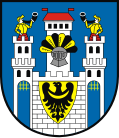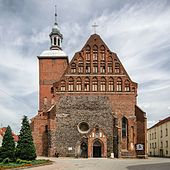Szprotawa
| Szprotawa | ||
|---|---|---|

|
|
|
| Basic data | ||
| State : | Poland | |
| Voivodeship : | Lebus | |
| Powiat : | Żagań | |
| Area : | 10.94 km² | |
| Geographic location : | 51 ° 34 ' N , 15 ° 32' E | |
| Height : | 132 m npm | |
| Residents : | 11,820 (Jun. 30, 2019) |
|
| Postal code : | 67-300 | |
| Telephone code : | (+48) 68 | |
| License plate : | FZG | |
| Economy and Transport | ||
| Street : | Zielona Góra - Jelenia Góra | |
| Next international airport : | Wroclaw Airport | |
| Gmina | ||
| Gminatype: | Urban and rural municipality | |
| Gmina structure: | 23 localities | |
| Surface: | 232.31 km² | |
| Residents: | 20,684 (June 30, 2019) |
|
| Population density : | 89 inhabitants / km² | |
| Community number ( GUS ): | 0810073 | |
| Administration (as of 2016) | ||
| Mayor : | Józef Rubacha | |
| Address: | Rynek 45 67-300 Szprotawa |
|
| Website : | www.szprotawa.pl | |
Szprotawa [ ʂprɔ'tava ] ( German Sprottau ) is a town in the powiat Żagański in the Polish Lubusz Voivodeship .
Geographical location

The city is located in Lower Silesia at the mouth of the sprat , which flows into the Bober from the right , about 37 kilometers west-southwest of Glogau .
history
The first mention of the place comes from a meeting of the German Emperor Otto III. with the Polish Duke Bolesław Chrobry in the Ilva Castle in 1000 on his way to the canonization of Adalbert of Prague in Gniezno . This castle is now generally equated with the mighty former castle complex Chrobry in the district of Iława (formerly German Eulau ).
In 1254 Sprottau received the German town charter from the first Piast Duke of Glogau, Konrad II , who had been the Duke of Sprottau since 1251 . Preserved sources of the city date from the year 1263. The city developed very quickly: As early as 1304, his son Konrad III confirmed. “Köberlein” of the city of Sprottau all city rights and privileges, including the internal organization of the city council “Concilium Magistratus”. Together with the Duchy of Glogau , Sprottau came to the Crown of Bohemia as a fief in 1331 , which the Habsburgs held from 1526 .
After the First Silesian War in 1742, Sprottau, like almost all of Silesia, fell to Prussia . Frederick II had the Frederician colonies of Eckhartswaldau (1775), Reußenfeldau (1776), Sprottischwaldau (1776) and Charlottenthal (1786) built; only “foreigners” (Saxony, Bohemia, etc.) were appointed as gardeners . These subjects were only subordinate to the King of Prussia, they were not allowed to be given services or labor. The Royal Glogau Chamber of War and Domains supervised the town of Sprottau when creating its new town villages.
After the reorganization of Prussia, Sprottau belonged to the province of Silesia in 1815 and from 1816 was the seat of the Sprottau district , which belonged to the Liegnitz administrative district.
In the first half of the 20th century, the city was in high economic prosperity thanks to the iron, textile and wax industries, including in particular Wilhelmshütte Eisen- und Emaillierwerke Aktiengesellschaft in the Eulau district , whose furnace factory alone had more than 400 jobs. In 1939 the city had 12,578 inhabitants.
At the end of the war in 1945, Sprottau was almost 90% destroyed. At the end of the Second World War , Sprottau was occupied by the Red Army in the spring of 1945 . It was then placed under Polish administration and renamed Szprotawa . In the following period the German population was expelled by the local Polish administrative authority . As a result, the population decreased significantly. In 1946 there were only 2,672 inhabitants. Poles migrated to the area, most of whom came from the areas east of the Curzon Line that had fallen to the Soviet Union . Lemken were also forced to settle in the empty settlements.
Sprottau has a catholic parish church that is well worth seeing, built between the 13th and 16th centuries.
City fires
- 1473 Church and monastery burn down, loss of all documents from the past
- 1630 Town hall, castle and Georgenkirche go up in flames
- 1672 Conflagration destroys the whole city
- 1702 Third major fire in the city
- 1796 21 houses burn down
- Population development
| year | Residents | Remarks |
|---|---|---|
| 1825 | 2,914 | including 616 Catholics and 27 Jews |
| 1840 | 3,725 | thereof 2,951 Evangelicals, 710 Catholics and 64 Jews |
| 1843 | 4.102 | at the end of the year, including 3,273 Evangelicals, 773 Catholics and 56 Jews |
| 1905 | 7,900 | with the garrison (a regiment of field artillery No. 5), including 1,762 Catholics and 66 Jews |
| 1925 | 10,366 | thereof 8,398 Evangelicals, 1,806 Catholics, six other Christians and 45 Jews |
| 1933 | 11,992 | thereof 8,769 Evangelicals, 2,013 Catholics, five other Christians and 35 Jews |
| 1939 | 11,974 | of which 9,562 Protestants, 2,060 Catholics, 34 other Christians and 13 Jews |
Attractions

- Early Gothic church from the 13th century
- Remains of the city wall
- Town hall with two towers. The eastern one, in Renaissance style, dates from the 16th century, the western one was built in the 17th century.
- Assumption Church from the 13th century
- Late Romanesque St. Andrew's Church
- Town houses
- Evangelical Church (ruin)
- Former building of the Magdalen convent Sprottau
- Sagan Gate
- The three trenches
- Muzeum Ziemi Szprotawskiej ( Museum of the Sprottauer Land )
- Wallburg Chrobry
- Mulberry tree in the Frederician colony of Sprottischwaldau, from the founding year 1776, property no.16 and contemporary colonist house with a baroque dormer window , house number 13
- Residential tower in the Witków district ( Wittgendorf )
traffic
The Szprotawa station is on the railway line Łódź – Forst (Lausitz), which is no longer used for passenger traffic . The Grünberg – Sprottau small railway used to end here. The roads lead to the neighboring towns west to Żagań (Sagan) u. Żary (Sorau) , east to Przemków (Primkenau) , north to Nowa Sól (New Salt) and south to Bolesławiec (Bunzlau) .
local community
The urban and rural municipality ( gmina miejsko-wiejska ) Szprotawa includes not only the city itself, but also the following localities:
|
|
Personalities
sons and daughters of the town
- Nickel Jacob (1505–1576), author of the first German bee book
- Jakob Ebert (1549–1614), theologian
- Johannes Buchwälder (1564–1632), studied theology, pastor and author in Wittenberg
- Christoph Preibisius (1580–1651), philosopher, natural and legal scientist
- Benjamin Ursinus (1587–1633), mathematician
- Martin Gumprecht (1597–1679) exile , court preacher in Dresden, pastor in Bautzen, doctor of philosophy and theology in Wittenberg
- Heinrich Göppert (1800–1884), botanist and paleontologist
- Carl-Friedrich Zimpel (1801–1879), officer of the Prussian infantry, railway technician, healer
- Heinrich Laube (1806–1884), writer
- Ferdinand Genähr (1823–1864), missionary of the Rhenish Mission in China
- Karl Bartsch (1832–1888), Germanist
- Robert Beisert (1833–1893), member of the Reichstag
- Wilhelm Fechner (1835–1909), portrait and genre painter and photographer
- Konstantin Fritsch (1857–1934), administrative lawyer and President of the Reich Railway Authority
- Harald Bielfeld (1863–1933), politician
- Arthur Hoffmann (1900–1945), resistance fighter against National Socialism from Wiechlice, Szprotawa municipality
- Walter Dötsch (1909–1987), painter
- Hans-Joachim Höfig (1915–2006), sports official
- Manfred Steinbach (* 1933), track and field athlete, Olympic participant and sports official
- Jürgen Borchhardt (* 1936), classical archaeologist
- Roswitha Berndt (* 1936), historian
- Klaus Hänsch (* 1938), former President of the European Parliament
- Rudolf Langer (* 1939), athlete
- Eva-Maria Bergmann (1941–2016), painter and graphic artist
- Detlev Kittstein (1944–1996), athlete and Olympic champion in field hockey
- Fritz Puppel (* 1944), rock musician and composer, founder of the East German rock band City
Honorary citizen
- Klaus Hänsch (* 1938), European politician
- Aleksander Kwaśniewski (* 1954), President
- Klaus Solmecke (* 1942), former mayor of Gevelsberg
- Heinrich Göppert (1800–1884), botanist and paleontologist
Twin cities
- Spremberg , Brandenburg
- Gevelsberg , North Rhine-Westphalia
The town twinning with Gevelsberg was established with an official ceremony on May 17, 1996 in the Aula West of Gevelsberg. There is a lively exchange with the Sankt Engelbert congregation. The tenth anniversary of the town twinning was officially celebrated in Sprottau from June 16 to 18, 2006.
Web links
- http://www.szprotawa.org.pl/
- http://www.szprotawa.pl/
- http://kreis-sprottau.npage.de/sp-st.html
- https://www.kulturwerk-schlesien.de/kulturlandschaftschlesien/staedte/artikel/536.Sprottau-Szprotawa.html
Individual evidence
- ↑ a b population. Size and Structure by Territorial Division. As of June 30, 2019. Główny Urząd Statystyczny (GUS) (PDF files; 0.99 MiB), accessed December 24, 2019 .
- ↑ in the chronicle of Thietmar von Merseburg
- ↑ Sprottischwaldau, Chronicle of the Colony 1776–1945, Szprotawka Kronika kolonii 1945–2010, A Frederician settlement in Lower Silesia, by Jürgen Gerner, Schwerin 2009, self-published, Szprotawa State Museum in Poland, (documents serial number 770–773)
- ^ The foundation and establishment of the new forest colony near Sagan 1775 , p. 361 in: Georg Steller: The Frederician settlement Reußenfeldau near Rückersdorf, Kr. Sprottau . Sprottau 1936, self-published
- ^ Georg Steller: The Frederician settlement of Reußenfeldau near Rückersdorf, Kr. Sprottau. Sprottau 1936, self-published, p. 11; P. 14, preparations: “They had to allow their subjects to let go as soon as they wanted to settle.” VI. Fridirizian settlements around Sagan and Sprottau (p. 57), 1. Eckartswaldau (p. 58), 2. Sprottischwaldau (p. 59)
- ↑ Georg W. Strobel: Ukrainians and Poles as a problem of national structural change and restructuring in East Central Europe after the Second World War , Cologne 1965, online (PDF)
- ^ Christian Friedrich Emanuel Fischer: Contemporary history of the cities of Silesia . Ed .: Carl Friedrich Stuckart. tape 3 . Schweidnitz.
- ^ Johann Georg Knie : Alphabetical-statistical-topographical overview of the villages, spots, towns and other places of the royal family. Prussia. Province of Silesia, including the Margraviate of Upper Lusatia, which now belongs entirely to the province, and the County of Glatz; together with the attached evidence of the division of the country into the various branches of civil administration . Breslau 1830, pp. 1023-1024.
- ↑ a b Johann Georg Knie : Alphabetical-statistical-topographical overview of the villages, towns, cities and other places of the royal family. Preusz. Province of Silesia . 2nd edition, Breslau 1845, pp. 929-932.
- ^ Meyer's Large Conversational Lexicon . 6th edition, Volume 18, Leipzig / Vienna 1909, p. 798.
- ^ A b c Michael Rademacher: German administrative history from the unification of the empire in 1871 to the reunification in 1990. Sagan. (Online material for the dissertation, Osnabrück 2006).
- ↑ Maciej Boryna: Sensacje Ziemi Szprotawskiej. Wyd. 1. Zielona Góra: Maciej Boryna, 2000, p. 12. ISBN 83-913508-0-0 .
- ↑ Info on wrotalubuskie.eu (accessed April 1, 2018)
- ↑ Joachim Lukas: Landeskunde Notes from Silesia - residential towers in Silesia online (PDF; accessed on November 16, 2016)
- ↑ Martin Gumprecht's biography
- ↑ Commemorative publication (PDF; 898 kB)






